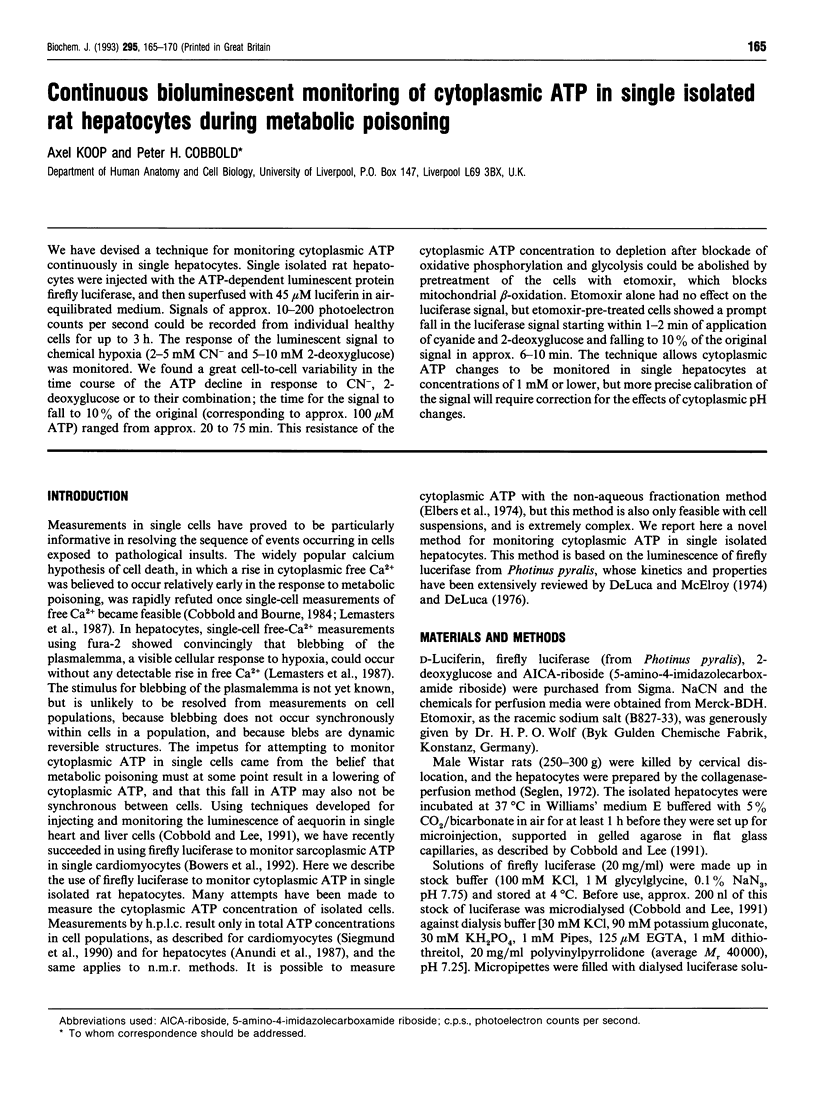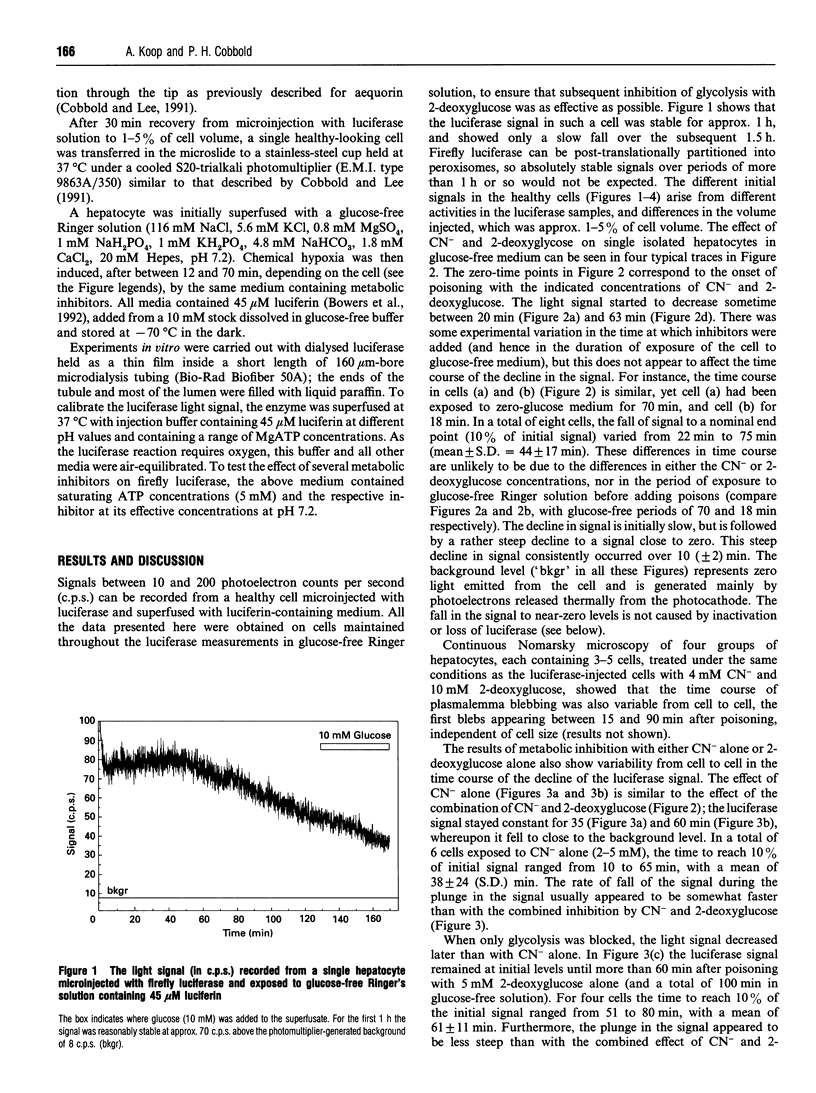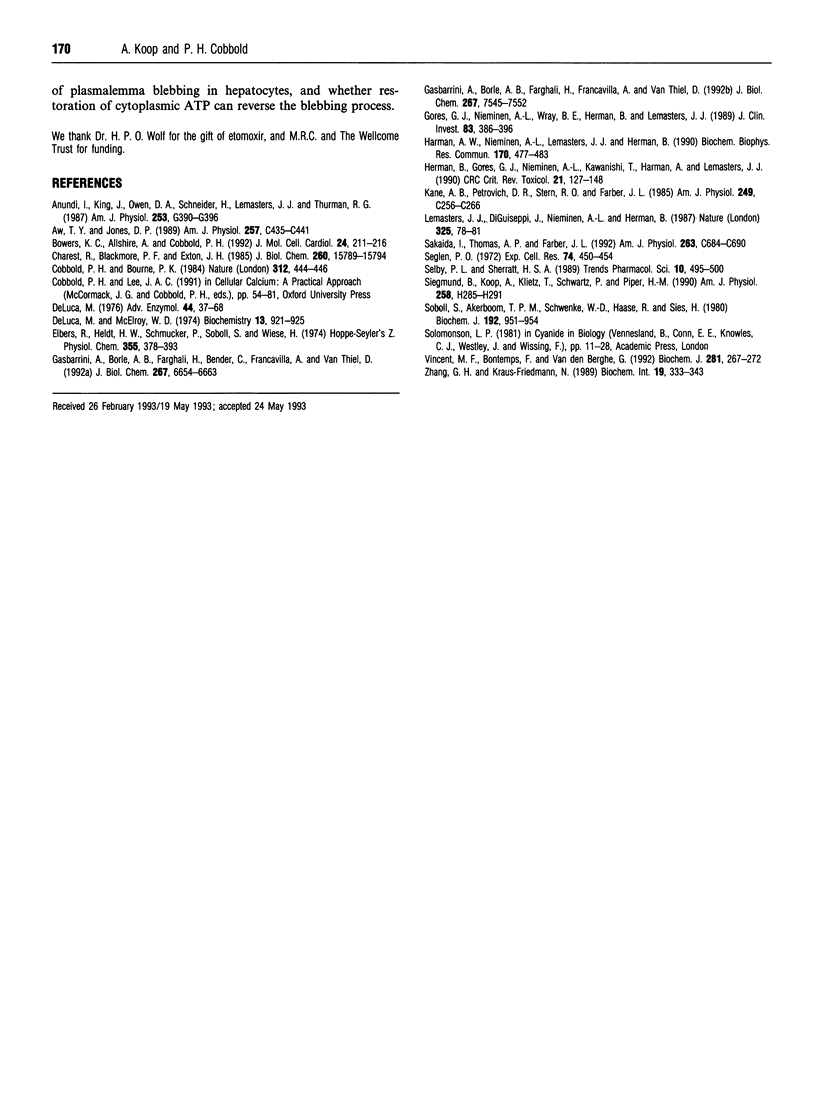Abstract
We have devised a technique for monitoring cytoplasmic ATP continuously in single hepatocytes. Single isolated rat hepatocytes were injected with the ATP-dependent luminescent protein firefly luciferase, and then superfused with 45 microM luciferin in air-equilibrated medium. Signals of approx. 10-200 photoelectron counts per second could be recorded from individual healthy cells for up to 3 h. The response of the luminescent signal to chemical hypoxia (2-5 mM CN- and 5-10 mM 2-deoxyglucose) was monitored. We found a great cell-to-cell variability in the time course of the ATP decline in response to CN-, 2-deoxyglucose or to their combination; the time for the signal to fall to 10% of the original (corresponding to approx. 100 microM ATP) ranged from approx. 20 to 75 min. This resistance of the cytoplasmic ATP concentration to depletion after blockade of oxidative phosphorylation and glycolysis could be abolished by pretreatment of the cells with etomoxir, which blocks mitochondrial beta-oxidation. Etomoxir alone had no effect on the luciferase signal, but etomoxir-pre-treated cells showed a prompt fall in the luciferase signal starting within 1-2 min of application of cyanide and 2-deoxyglucose and falling to 10% of the original signal in approx. 6-10 min. The technique allows cytoplasmic ATP changes to be monitored in single hepatocytes at concentrations of 1 mM or lower, but more precise calibration of the signal will require correction for the effects of cytoplasmic pH changes.
Full text
PDF





Selected References
These references are in PubMed. This may not be the complete list of references from this article.
- Anundi I., King J., Owen D. A., Schneider H., Lemasters J. J., Thurman R. G. Fructose prevents hypoxic cell death in liver. Am J Physiol. 1987 Sep;253(3 Pt 1):G390–G396. doi: 10.1152/ajpgi.1987.253.3.G390. [DOI] [PubMed] [Google Scholar]
- Aw T. Y., Jones D. P. Cyanide toxicity in hepatocytes under aerobic and anaerobic conditions. Am J Physiol. 1989 Sep;257(3 Pt 1):C435–C441. doi: 10.1152/ajpcell.1989.257.3.C435. [DOI] [PubMed] [Google Scholar]
- Charest R., Blackmore P. F., Exton J. H. Characterization of responses of isolated rat hepatocytes to ATP and ADP. J Biol Chem. 1985 Dec 15;260(29):15789–15794. [PubMed] [Google Scholar]
- Cobbold P. H., Bourne P. K. Aequorin measurements of free calcium in single heart cells. 1984 Nov 29-Dec 5Nature. 312(5993):444–446. doi: 10.1038/312444a0. [DOI] [PubMed] [Google Scholar]
- DeLuca M., McElroy W. D. Kinetics of the firefly luciferase catalyzed reactions. Biochemistry. 1974 Feb 26;13(5):921–925. doi: 10.1021/bi00702a015. [DOI] [PubMed] [Google Scholar]
- Deluca M. Firefly luciferase. Adv Enzymol Relat Areas Mol Biol. 1976;44:37–68. doi: 10.1002/9780470122891.ch2. [DOI] [PubMed] [Google Scholar]
- Elbers R., Heldt H. W., Schmucker P., Soboll S., Wiese H. Measurement of the ATP/ADP ratio in mitochondria and in the extramitochondrial compartment by fractionation of freeze-stopped liver tissue in non-aqueous media. Hoppe Seylers Z Physiol Chem. 1974 Mar;355(3):378–393. doi: 10.1515/bchm2.1974.355.1.378. [DOI] [PubMed] [Google Scholar]
- Gasbarrini A., Borle A. B., Farghali H., Bender C., Francavilla A., Van Thiel D. Effect of anoxia on intracellular ATP, Na+i, Ca2+i, Mg2+i, and cytotoxicity in rat hepatocytes. J Biol Chem. 1992 Apr 5;267(10):6654–6663. [PubMed] [Google Scholar]
- Gasbarrini A., Borle A. B., Farghali H., Francavilla A., Van Thiel D. Fructose protects rat hepatocytes from anoxic injury. Effect on intracellular ATP, Ca2+i, Mg2+i, Na+i, and pHi. J Biol Chem. 1992 Apr 15;267(11):7545–7552. [PubMed] [Google Scholar]
- Gores G. J., Nieminen A. L., Wray B. E., Herman B., Lemasters J. J. Intracellular pH during "chemical hypoxia" in cultured rat hepatocytes. Protection by intracellular acidosis against the onset of cell death. J Clin Invest. 1989 Feb;83(2):386–396. doi: 10.1172/JCI113896. [DOI] [PMC free article] [PubMed] [Google Scholar]
- Harman A. W., Nieminen A. L., Lemasters J. J., Herman B. Cytosolic free magnesium, ATP and blebbing during chemical hypoxia in cultured rat hepatocytes. Biochem Biophys Res Commun. 1990 Jul 31;170(2):477–483. doi: 10.1016/0006-291x(90)92116-h. [DOI] [PubMed] [Google Scholar]
- Herman B., Gores G. J., Nieminen A. L., Kawanishi T., Harman A., Lemasters J. J. Calcium and pH in anoxic and toxic injury. Crit Rev Toxicol. 1990;21(2):127–148. doi: 10.3109/10408449009089876. [DOI] [PubMed] [Google Scholar]
- Kane A. B., Petrovich D. R., Stern R. O., Farber J. L. ATP depletion and loss of cell integrity in anoxic hepatocytes and silica-treated P388D1 macrophages. Am J Physiol. 1985 Sep;249(3 Pt 1):C256–C266. doi: 10.1152/ajpcell.1985.249.3.C256. [DOI] [PubMed] [Google Scholar]
- Lemasters J. J., DiGuiseppi J., Nieminen A. L., Herman B. Blebbing, free Ca2+ and mitochondrial membrane potential preceding cell death in hepatocytes. Nature. 1987 Jan 1;325(6099):78–81. doi: 10.1038/325078a0. [DOI] [PubMed] [Google Scholar]
- Sakaida I., Thomas A. P., Farber J. L. Phospholipid metabolism and intracellular Ca2+ homeostasis in cultured rat hepatocytes intoxicated with cyanide. Am J Physiol. 1992 Sep;263(3 Pt 1):C684–C690. doi: 10.1152/ajpcell.1992.263.3.C684. [DOI] [PubMed] [Google Scholar]
- Seglen P. O. Preparation of rat liver cells. I. Effect of Ca 2+ on enzymatic dispersion of isolated, perfused liver. Exp Cell Res. 1972 Oct;74(2):450–454. doi: 10.1016/0014-4827(72)90400-4. [DOI] [PubMed] [Google Scholar]
- Selby P. L., Sherratt H. S. Substituted 2-oxiranecarboxylic acids: a new group of candidate hypoglycaemic drugs. Trends Pharmacol Sci. 1989 Dec;10(12):495–500. doi: 10.1016/0165-6147(89)90049-7. [DOI] [PubMed] [Google Scholar]
- Siegmund B., Koop A., Klietz T., Schwartz P., Piper H. M. Sarcolemmal integrity and metabolic competence of cardiomyocytes under anoxia-reoxygenation. Am J Physiol. 1990 Feb;258(2 Pt 2):H285–H291. doi: 10.1152/ajpheart.1990.258.2.H285. [DOI] [PubMed] [Google Scholar]
- Soboll S., Akerboom T. P., Schwenke W. D., Haase R., Sies H. Mitochondrial and cytosolic ATP/ADP ratios in isolated hepatocytes. A comparison of the digitonin method and the non-aqueous fractionation procedure. Biochem J. 1980 Dec 15;192(3):951–954. doi: 10.1042/bj1920951. [DOI] [PMC free article] [PubMed] [Google Scholar]
- Vincent M. F., Bontemps F., Van den Berghe G. Inhibition of glycolysis by 5-amino-4-imidazolecarboxamide riboside in isolated rat hepatocytes. Biochem J. 1992 Jan 1;281(Pt 1):267–272. doi: 10.1042/bj2810267. [DOI] [PMC free article] [PubMed] [Google Scholar]
- Zhang G. H., Kraus-Friedmann N. Demonstration of adenylate-kinase activity in hepatic microsomes. Relevance to Ca2+ uptake. Biochem Int. 1989 Aug;19(2):333–343. [PubMed] [Google Scholar]


